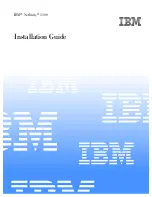
CHAPTER 14 Glossary
14.1
Glossary
Baud (Rate)
A unit of modulation speed, that reflects the number of elements occurring per second. One element
per second gives a 1 baud modulation, while two hundred elements per second (1 element = 5ms)
gives a 200 baud modulation. In the field of communications, the baud rate is often used
interchangeably with the number of signal bits per second (bps).
Branch Prediction
Branching occurs after the CPU evaluates a conditional command, or after it receives an external
input (interrupt). Normally, data is fed to the CPU in order of execution, but a branch means that the
instructions that have already been fed into the pipeline have to be flushed, and the CPU must wait
for the required instructions to be loaded before it can proceed. In extreme cases this can be a
considerable drain on performance, so rather than blindly feeding data to the CPU in order of
reception, if the presence of upcoming potential branches is noted, data can be preloaded into the
cache, and each branch followed by the sequence of instructions calculated as being most likely to
be called after the branch. Of course sometimes the prediction will be wrong and data will still have
to be flushed and reloaded, but the more accurate the prediction, and the better the preloading, the
lower the performance penalty becomes.
Bus (Line)
A path (circuit, signal line, etc.) or set of paths that is capable of transferring a signal, usually
between components within the system (e.g. CPU
<
=
>
memory) or a system component and a
peripheral device (e.g. CPU
<
=
>
hard disk).
Bus Protocol
The (predefined) logical structure and timing of the signals that are passed over a bus.
Cache (Primary or L1 Cache)
In order to prevent a fast CPU from having to wait for access to the relatively slow external
memory, a small amount of very fast memory is often included within the CPU itself, and frequently
used data and instructions are stored in this level one (L1) cache memory.
Cache (Secondary or L2 Cache)
Although very fast, L1 cache is also very expensive, and it is often impractical to add large amounts
of it to the CPU design. However, it is relatively easy to add more fast memory close to, but not in
the CPU, and this level two (L2) cache memory, while slower (and usually larger) than the L1
cache, is faster than the main memory, for improved system performance.
Checksum
A hash value calculated (e.g. using parity) in some way from a set of data, and then appended to it
or compared with a previously appended checksum in order to validate the integrity of the data set
(after transmission, retrieval from storage, etc.). Basically, even the most minor change to the data
will produce a different checksum value, hence an error can be flagged if the calculated and
transmitted/retrieved checksum values do not match.
Console (Terminal)
A device that allows the operator to communicate with and control the computer. A keyboard and
display are standard, but other I/O devices are also sometimes used.
240
Summary of Contents for Primepower200
Page 1: ...P321 E122 04EN PRIMEPOWER PRIMEPOWER200 PRIMEPOWER400 PRIMEPOWER600 ...
Page 2: ......
Page 12: ......
Page 116: ......
Page 142: ......
Page 192: ......
Page 254: ......
Page 255: ...12 RCI Commands CONTENTS 12 1 Overview 228 12 2 RCI Commands 228 227 ...
Page 258: ......
Page 266: ......
Page 267: ...14 Glossary CONTENTS 14 1 Glossary 240 239 ...
Page 272: ......





































